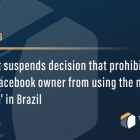Clique aqui para ler esta notícia em português.
One of the aspects that begets more hatred in discussions about blockchain is its high adaptability to different purposes and situations, which can be implemented in any economic sector. Furthermore, the possibility of interoperability is a relevant factor.
This concept refers to the ability of different systems, devices, or components to integrate, interact, and work together efficiently and effectively.
This way, you now have at your disposal a malleable technology, which operates as a digital “ledger” capable of storing any transactions and records in an immutable way and visible to everyone.
The events sector and its great enemy
One of the most cited examples of tokenization and its use cases is the events and ticketing sector. This segment, representing 3.8% of Brazilian GDP, has experienced notable growth, US$59.3 billion.
However, proportional to its growth, cases of scams and fraud are emerging, along with increased purchasing bots intended for resale. Measures against currency exchange, despite existing, prove to be inefficient and result in double losses, both for customers and for producers, organizers, and artists.
A problem that is not only solved with blockchain but also brings with it new ranges of possibilities.
Security, practicality, and new layers of interaction
When transforming a ticket into an NFT or digital collectible, the magic of interoperability happens, simultaneously allowing countless benefits and actions. Starting with the unique registration of the visa issued, which cannot be duplicated, guaranteeing its security and legitimacy.
Decentralization grants the buyer absolute ownership of this item, which becomes an asset capable of resale in a safe secondary market. Mediated by the organizer, this market can also allow the collection of royalties, opening up the possibility of a new source of income for artists.
Due to its transparent registration, verifying and monitoring this user becomes possible, allowing more effective monitoring and access to more comprehensive data on the entire consumer journey and their preferences, which can serve as valuable material in optimizing experiences.
This ticket becomes not just a token but also a true collectible, enabling the development of unique and commemorative art. This rescues the memorabilia element, previously present in physical tickets, but, unlike these, it does not deteriorate or get lost.
This element also allows extensive customization, offering exclusive content, benefits, and promotions to specific holders, expanding the layers of interaction, and constructing an entire community around the platform, artists, and these mechanics.
All of this happens in a context that is culturally accessed by an audience that is naturally engaged and interested in collecting and being impacted by experiences related to the events of which they are fans.
With examples from all over the world, the largest is from Brazil
Getting off the ground, countless events worldwide have already experimented with and benefited from ticket tokenization. Renowned festivals, such as the Coachella Festival Formula 1 in Monaco, and specific artists, such as Milton Nascimento’s farewell tour and Avenged Sevenfold’s exclusive access club, are some examples of events that used blockchain to develop unique experiences.
Large platforms, including Ticketmaster, have taken the first steps in adoption, carrying out test ticket issuances using NFTs.
In Brazil, the first central platform to enter this market is Sympla, which is starting its plans by tokenizing its tickets. Initially, the focus is on improving security and the possibility of resale, emphasizing user experience.
With 15 million users and 44 million tickets sold registered last year, this adoption and its possibilities will represent the most significant use case of ticket tokenization in the world, solidifying Brazil as one of the exponents of this technology.







